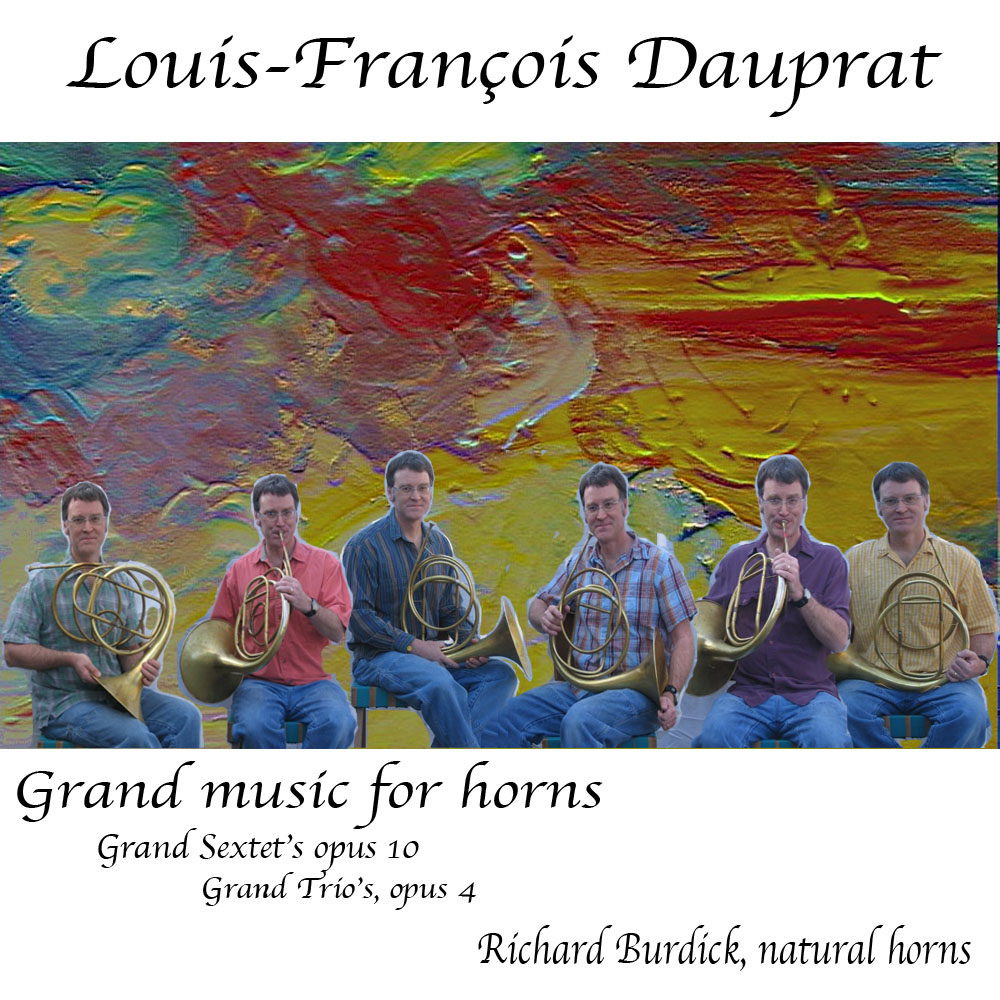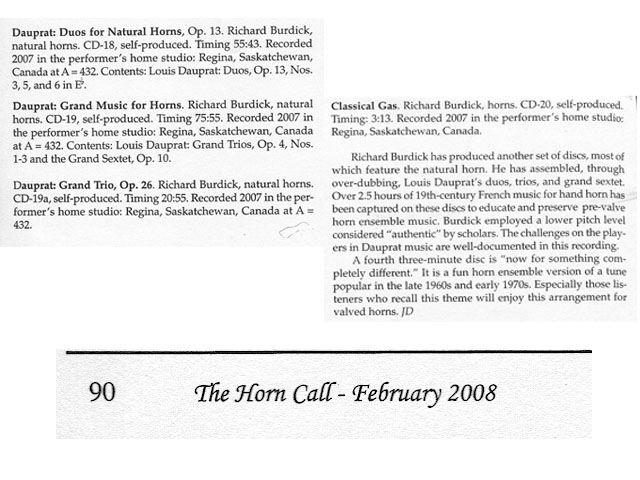
 Follow on Twitter
Follow on Twitter Grand Sextet's
Grand Sextet'sThis release date
marks the completion of the recording of all of Dauprat's
horn ensemble music by Richard Burdick. With the 2nd volume
of Horn Duets opus 13 on CD 18, the Grand Sextets, opus
10 and the Grand Trios opus 4 on CD19 and a special release
of the Grand Trio opus 26 on a disk for those who buy both
CD18 & 19! |
Already released are CD16; the Duets opus 14, and CD14; Quartets, opus 8; which is all of the published music for horn ensemble of Dauprat.
Why is this important? Louis-François Dauprat was the horn professor at the Paris conservatory in Beethoven's time. He was singly responsible for stalling the development of the Valve horn in France, by as much as 40 years! His compositions are fine early romantic works highly influenced by his teacher Anton Reicha. His writing for natural horn is unbelievably chromatic with keys remote from what would be expected in what normally would be a very limited instrument.
His works are outstanding! His Grand sextets are his most popular works partialy due to his use of the High C horn, which resluts in high D for the modern horn or concert G's above the treble clef staff!
Performance of his works could only be done by a virtuoso! Great mastery of the natural horn is required to play these works; hear one of today’s few natural horn artist. in this amazing recording.
| Grand Sextets for horns in different keys, opus 10 by Dauprat | ||||||||||||||||||||||||
|
||||||||||||||||||||||||
| Grand Trios, opus 4 #1 | ||||||||||||||||||||||||
|
||||||||||||||||||||||||
| Grand Trios, opus 4 #2 | ||||||||||||||||||||||||
|
||||||||||||||||||||||||
| Grand Trios, opus 4 #3 | ||||||||||||||||||||||||
|
||||||||||||||||||||||||
Total time 75:55 |
REVIEW:
Dauprat’s intimate knowledge
of hand horn techniques makes this opus a compositional tour de
force. Not only does he use all twelve notes of the chromatic scale
in nearly every piece, he also pioneers the use of key signatures
of up to four sharps and four flats for an instrument which was
generally restricted to C major. His stated purpose in writing
these duos was
to write in all the major and minor scales practicable on a single
crook. His ideas of what was practicable went far beyond the usual
practice of his time, and his goal was at least as much aesthetic
as technical. He exploited the positioning of stopped notes to produce
distinct moods and tone qualities for each key, much as J.S. Bach
did in the Well-Tempered Clavier. For the natural horn, C major and
the sharp keys are cheerful and brilliant because they contain many
open notes. The sharp notes are often leading tones, so the hand
position is more open than would otherwise be the case.
Richard plays a horn made by Marcel-Auguste Raoux in the 1840s, modified by Lowell Greer.

A review from musicweb-international:
Louis François Dauprat is unlikely to be a familiar name even to readers of these pages. He was a French horn player, teacher and composer who had considerable success as a soloist and orchestral performer. Among other works he published five horn concertos. He was also a noted teacher and his Méthode pour cor alto et cor basse is said to be unsurpassed.
Dauprat was the winner of the first “premier prix” for a horn player, travelling with military bands before completing his studies and later becoming a professor at the National Institute or Conservatoire of Music. He also played in the courts of Napoleon, Louis XVIII, Charles X and Louis-Philippe. After these positions Dauprat went into semi-retirement in Egypt until shortly before his death. He specialised in teaching, and his treatises convey detailed methods and performance instructions. All of this I have gleaned from the web. There is no information with the CD.
There is however plenty on information on Canadian horn player Richard Burdick’s distinguished career on the websites given above, so I shall restrict myself to commenting on the music and how it appears on this disc.
Richard Burdick has recorded all of the parts for these horn ensemble pieces, something which he had already done with Dauprat’s Grand Duos. The cute picture of the same player pretending to be six different ones by dint of a change of shirt illustrates this. I’m just an old Mr. Picky, but a change of trousers would have made the effect more convincing. There are inevitable disadvantages to recording music in this way, and the tracks do lack a feel of real abandon where the music becomes more lively. The multi-tracking has been bathed in a glow of what sounds like artificial reverberation, and the results in the Grand Sextet make it seem as if the players are performing to you from the bottom of a large well. This effect is however not entirely unpleasant, and is less in evidence with the Grand Trios. The restrictions and artificiality of the studio environment are only worth noting if you are hoping for the kind of abandoned and free-blowing fun which you get from someone like Hermann Baumann. The Grand Sextet also has a little comb-and-paper left-channel buzz at certain pitches which is unfortunate, but is a relatively small irritant other than on headphones. The general aural picture from Burdick’s sound is one of quite gentle and refined music-making, which, rather surprisingly would appear suitable as much for performance in a domestic setting as the hue and cry of open-air horn playing. There is no reason why this should not be the case. Dauprat’s high-classical writing is idiomatically hand-in-glove with the nature of an instrument which falls into the softer world of early music and historical performance. Burdick’s expertise means that any extremes of range which do occur are well balanced and always in control.
The natural horn is a punishingly difficult instrument to play well, and I dearly love the sense of strain and variety of colour and tuning which is all part of the techniques of obtaining a tune by pushing air into what is after all just a curled up length of metal tube. There are no keys to facilitate easy chromaticism, and the player has to use hand-stopping to adjust for and to obtain certain pitches. There are a few moments where the playing goes off the rails a little here and there on this disc, but in general the performances are very good, and Richard Burdick is to be complimented on his execution of a project which would be tricky enough to bring off under any circumstances. I think I would ultimately prefer a recording in which the contrasts in the music and playing were allowed more freedom with an ensemble of different players and their accompanying variety of instruments, but I don’t know anywhere else where you can find this repertoire, so it’s hats off once again. Dauprat’s music is deceptively easy on the ear, but within a classical idiom and with the technical restrictions of the instrument his inventiveness and creative prowess is much to be admired. I suppose a fair comparison might be made with something like the wind quintets of Antonin Reicha, if you are looking for stylistic equivalents.
Richard Burdick has plenty of sound samples on his website, so you can go along and see for yourself if this will be worth your while. Beyond being of interest to horn specialists, this is an interesting and unusual sound which I for one have found quite entertaining in an undemanding, background music kind of way. I know of a few horn clubs who will be interested in this, so I shall of course be spreading the word – whoop whoop!
Dominy Clements
(Thank you Dominy)
https://www.musicweb-international.com/classrev/2008/Aug08/Dauprat_horns_CD19.htm
Tracks:
1) Grand Sextet for natural horns in different keys, Op. 10: 1. Introduction
2) Grand Sextet for natural horns in different keys, Op. 10: 2. Minuetto
3) Grand Sextet for natural horns in different keys, Op. 10: 3. Andante
4) Grand Sextet for natural horns in different keys, Op. 10: 4. Minuetto
5) Grand Sextet for natural horns in different keys, Op. 10: 5. Adagio
6) Grand Sextet for natural horns in different keys, Op. 10: 6. Allegro moderato
7) Grand Trio for natural horns, Op. 4 No. 1: 1. Allegro moderato
8) Grand Trio for natural horns, Op. 4 No. 1: 2. Adagio ma non troppo
9) Grand Trio for natural horns, Op. 4 No. 1: 3. Minuetto
10) Grand Trio for natural horns, Op. 4 No. 1: 4. Rondeau
11) Grand Trio for natural horns, Op. 4 No. 2: 1. Allegro altiermente
12) Grand Trio for natural horns, Op. 4 No. 2: 2. Canon - andante
13) Grand Trio for natural horns, Op. 4 No. 2: 3. Minuetto - allegro
14) Grand Trio for natural horns, Op. 4 No. 2: 4. Agitato non troppo
15) Grand Trio for natural horns, Op. 4 No. 3: 1. Introduction - lento, allegretto
16) Grand Trio for natural horns, Op. 4 No. 3: 2. Romanza
17) Grand Trio for natural horns, Op. 4 No. 3: 3. Minuetto
18) Grand Trio for natural horns, Op. 4 No. 3: 4. Finale - Allegro non troppo